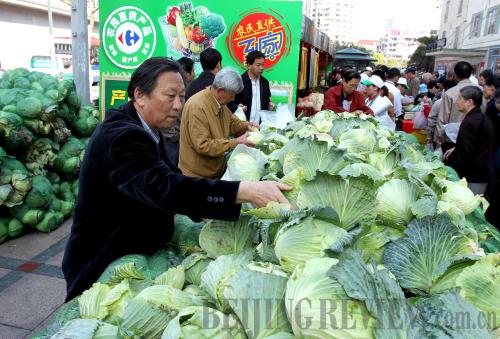|
 |
|
A PROBLEM FOR ALL: Customers select cabbage at a supermarket in Shanghai. Selling prices for farmers have dropped steeply but retail prices in cities are still high (LIU YING) |
The weather has also been to blame for vegetable price fluctuations. Temperatures in north China this year have been higher than usual, causing vegetables produced in north and south China to arrive at markets almost simultaneously. Others point fingers at the nuclear accident in Japan, since radioactive materials have been detected in certain vegetables, like spinach. The result has been a near moratorium on the part of dealers to purchasing these vegetables out of fear that they will remain on store shelves.
Measures
On April 21, MOFCOM issued five measures to handle farmers' troubles in selling their produce and maintain market stability. First, commerce departments will strengthen market monitoring of vegetable prices and sales volume and stay on top of changes in consumer demand. Second, commerce departments will establish platforms for vegetable growers to issue information, seek business opportunities and expand logistics channels. Third, commerce departments will help connect farmers and supermarkets and other sellers in order to reduce costs of intermediate links. Fourth, commerce departments will organize intensive processing of vegetables and expand vegetable consumption. They will help food-processing enterprises and major vegetable-producing areas to establish long-term cooperation mechanisms to alleviate sales pressure. Fifth, commerce departments will purchase vegetables to store in reserve.
On April 26 and 27, MOFCOM issued two circulars requiring local commerce departments to adopt more specific measures to help farmers sell their produce and maintain market stability.
MOFCOM also required commerce departments to help farmers buy insurance and establish special relief mechanisms to prevent low vegetable prices from substantially hurting farmers.
MOFCOM's efforts seem to be paying off. On April 27, the purchase price of cabbage in Shandong increased from 0.16 yuan per kg to 0.3 yuan (almost $0.05) per kg, the minimum price for farmers to recover their costs.
Low vegetable prices hurt farmers, but high vegetable prices hurt consumers. Preventing steep fluctuations in vegetable prices has become the task at hand for government officials at all levels. At a discussion organized by the NDRC on April 25, experts analyzed the situation and presented research on future vegetable prices.
Chen Dongqi, Deputy Director of the NDRC Academy of Macroeconomic Research (AMR), said to control prices, the government needs to stabilize production of vegetables, increase effective supplies, reduce logistics costs and improve the logistics system.
Wu Xiaoqiu, Director of the Department of Forecast of the AMR, said farmers are a disadvantaged group and an under-represented or overlooked party during negotiations. Controlling sales channels, middlemen at various levels raise prices to seek handsome profits, and it's ultimately the buyers who bear the high prices. The main solution to this problem is to reduce logistics fees. Relationships are also being fostered between farmers and supermarkets, although these are few and far between for the time being.
The NDRC decided to stabilize vegetable prices the government would give fully play to price regulation funds and support the construction of vegetable greenhouses. In the logistics sector the government will support construction of cold stores in order to increase the scale of vegetable reserves and regulate supplies in different seasons. In the consumption sector the government will support the construction of non-profit wholesale markets and low-price vegetable shops in communities.
The NDRC is preparing to establish a monitoring and warning system on the information of prices, costs in production links, logistics and consumption that covers all major vegetable varieties. The commission is formulating the price index of bulk farm produce and expanding price information publicizing channels. It is preparing to select 10 counties in each province to publicize these production and planting figures.
To date, the National Bureau of Statistics, the Ministry of Agriculture, MOFCOM and even Xinhua News Agency have their own statistics on agricultural prices, but there are still no figures on vegetable production and planting in China, which are sorely needed.
"If such a statistical system can be established, it will be greatly beneficial for all," said Chen Mingjun, Deputy Secretary General of the China Vegetable Marketing Association.
But, Chen says, it is still difficult to network such figures and make them authoritative. | 